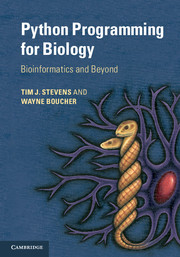Book contents
- Frontmatter
- Contents
- Preface
- Acknowledgements
- 1 Prologue
- 2 A beginners’ guide
- 3 Python basics
- 4 Program control and logic
- 5 Functions
- 6 Files
- 7 Object orientation
- 8 Object data modelling
- 9 Mathematics
- 10 Coding tips
- 11 Biological sequences
- 12 Pairwise sequence alignments
- 13 Multiple-sequence alignments
- 14 Sequence variation and evolution
- 15 Macromolecular structures
- 16 Array data
- 17 High-throughput sequence analyses
- 18 Images
- 19 Signal processing
- 20 Databases
- 21 Probability
- 22 Statistics
- 23 Clustering and discrimination
- 24 Machine learning
- 25 Hard problems
- 26 Graphical interfaces
- 27 Improving speed
- Appendices
- Glossary
- Index
- Plate section
- References
11 - Biological sequences
Published online by Cambridge University Press: 05 February 2015
- Frontmatter
- Contents
- Preface
- Acknowledgements
- 1 Prologue
- 2 A beginners’ guide
- 3 Python basics
- 4 Program control and logic
- 5 Functions
- 6 Files
- 7 Object orientation
- 8 Object data modelling
- 9 Mathematics
- 10 Coding tips
- 11 Biological sequences
- 12 Pairwise sequence alignments
- 13 Multiple-sequence alignments
- 14 Sequence variation and evolution
- 15 Macromolecular structures
- 16 Array data
- 17 High-throughput sequence analyses
- 18 Images
- 19 Signal processing
- 20 Databases
- 21 Probability
- 22 Statistics
- 23 Clustering and discrimination
- 24 Machine learning
- 25 Hard problems
- 26 Graphical interfaces
- 27 Improving speed
- Appendices
- Glossary
- Index
- Plate section
- References
Summary
Bio-molecules for non-biologists
This section is aimed at programmers who do not have much biological training, to explain a little about where biological sequences come from. Naturally we must omit a large amount of detail if we’re going to keep things short enough for this book. The emphasis will be about how information is stored, transferred and interpreted in biological systems to ultimately give the chemistry of life. We leave details of the current understanding of the precise mechanisms to your enthusiasm and further reading.
Life can be thought of as a set of controlled chemical reactions and interactions that build and maintain organisms. When there is no control over biochemistry the raw materials of an organism soon succumb to decay; complex biological molecules turn into much simpler, more stable forms. The specific set of chemical reactions and interactions that allow life to live and reproduce are mostly directed by protein molecules with occasional roles for RNA molecules.
Proteins
The different kinds of protein molecules that direct the processes needed for life are different because they are made up of different sequences of smaller entities, amino acids (see Figure 11.1). This sequence specifies their shape, physical properties, movement and chemical activity. There are 20 common amino acid types that are joined together into chains of varying length to make the various proteins. The amino acids are joined together into a linear sequence by chemical bonds that are referred to as peptide links, thus protein chains are frequently referred to as polypeptides. Most proteins adopt a particular three-dimensional arrangement as segments of the amino acid entities within the chain come together into one or more compact globules. The final shape of a protein is usually vitally important for its function, and this shape is governed by the combination and order of amino acids in the polypeptide chain. However, it should be noted that the relationship between protein sequence and structure is exceedingly complex, such that we cannot generally predict a protein’s structure directly from its sequence alone.
- Type
- Chapter
- Information
- Python Programming for BiologyBioinformatics and Beyond, pp. 181 - 207Publisher: Cambridge University PressPrint publication year: 2015
References
- 1
- Cited by



